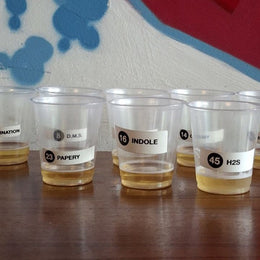The basic structure to most tasting notes includes:
- The appearance or colour
- The smell (on the nose)
- The taste (on the palate)
- The finish
1. Appearance or colour
Presentation informs the palate. Michelin chefs would say that you eat with your eyes first. Similarly, tasting notes cover the presentation and appearance of a whisky in the glass because that is a key step of your tasting experience.

Whisky colour spectrum. (Image Source: Whisky Magazine)

The writer generally begins by holding up the whisky in a tulip-shaped glass to observe the colour. He would comment on the colour of the liquid in impressionistic way.
A lighter-coloured whisky could be pale straw or white wine.
Ex-bourbon cask whiskies tend to be of golden colour. Meanwhile, ex-sherry cask whiskies could be described as having a copper or mahogany.

Gold-coloured with a set of nice legs. Source: VinePair Inc.
The writer sometimes comments on how thin or how thick the “legs” of the whisky are.
What on earth does that mean you say.
He simply swishes the whisky in the tulip glass and then observe the inner wall of the glass. The “legs” refers to streaks of whisky droplets trailing back down into the bowl which give us some indication of the spirit’s body.
The thinner, more rapidly the legs run down the glass, the lighter-bodied the whisky would be. Thicker and slower legs would indicate a more viscous and heavy-bodied whisky.
2. On the nose

Source: Jennifer Robertson
The writer then moves to nose the whisky for about 2 to 3 minutes and describes the bouquet of the whisky.
He would describe the smell of the whisky by references to common foods or fruits from daily life that the whisky reminds him of.
He could start tossing references to orchard fruits (eg apples, oranges), stone fruits (eg peaches, apricots), herbs (cinnamon, rosemary, peppermint), syrups (honey, golden syrup), desserts (chocolate, Christmas cake), nuts (walnut), various types of smokiness (cigar smoke, garden bonfire), or even obviously non-edible things (iodine, diesel, Band-aids, nail varnish).
Remember, the idea is to tell you what the bouquet of the whisky might remind you of, and not what the whisky smells exactly like.
Don’t expect a “chocolatey notes” whisky to taste like chocolate milkshake.
Order a Milo peng instead.
3. On the palate
The writer then moves on to taste the whisky and describe the flavours.
Again, he would toss some references, ditto the laundry list above. But amongst these references, you should look out for 3 main dimensions of flavours:
- Basic flavours of sweetness, smokiness, bitterness or saltiness (common amongst those made in coastal distilleries)
- Alcohol – how does the alcohol present itself? Is it soft and subtle? Smooth and well integrated? Does it warm your throat (and makes you taste “spiciness” or pepperiness)? Is it harsh and painful?
- Body and texture – what is the weight and viscosity of the whisky in your mouth? Is it light and crisp? Do the flavours somewhat cling on to your tongue (and feel “oily”)? Or is the whisky so full-bodied that takes over your entire palate and lingers?
Some writers use odd descriptors and claim their whisky is “chewy”. Of course, he doesn’t mean there are actual gummy bears in the liquid.
This is a texture associated with whiskies that have sweetness (of a sticky sort) with a rich and thick mouthfeel, somewhat reminiscent of the flavours in a toffee candy.
4. The finish
The writer then goes on to describe the “finish”.
Essentially, he describes what’s left to linger on the palate for the last few seconds after swallowing the whisky. The writer would describe how short or long (or if it’s medium) the finish lasts, whether the liquid goes down smoothly.
Sometimes, he would notice new flavours to be discovered after things have quietened down a little and the richer parts of the whisky have departed.
Concluding thoughts

Are you still following, Conan? Source: Team Coco Digital LLC.
The writer might add some concluding thoughts on his overall impression of the whisky.
What did he like about the whisky? Is there some complexity or balance (eg strong smokiness being balanced by robust sherried notes)?
Was anything unusual or surprising about the taste? Sometimes, a young whisky could have surprising complexity and smoothness.
It is not uncommon for the writer to talk about the feelings that the whisky evoke, and not just the literal smells and taste of a whisky. Whiskyfun described Kavalan’s 'Peated Malt' expression to evoke “a Saturday morning at Ikea” feeling together with the smells of plywood and linoleum.

For trade mark reasons, I won’t be reproducing a picture of Ikea. This is a Swedish prison. Source: Reddit
I hope you see at this point that discussing how a whisky makes you feel ain’t completely bullshit. Certain smells are nostalgia-inducing.
Our amazing sense of smell it is particularly powerful at unlocking our deepest memories. Smells directly stimulate the olfactory bulb, and simultaneously activates the medial amygdala and the entorhinal cortex – areas of our brain that store memories of emotionally compelling events.
For this reason, certain distinctive scents or tastes in a whisky could remind people of a certain activity or event they have experienced before - from the highly personal (like watching your mother spritzing a rose perfume) to the commonplace (walking through a rain-sodden field) to the downright mundane (opening an old, yellowed library book).
This also brings me back to this scene from Ratatouille:

You know that bit in Ratatouille, where the food critic takes one bite of a dish and is transported back to a childhood memory of his mother’s cooking?
Some writers even like to describe the character or personify the whisky. Robin Scherbatsky in How I Met Your Mother liked her Scotch “old enough to order its own Scotch”.

@charsiucharlie







